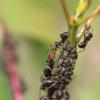Interesting, nice find, Drew!
Looks like your crickets suffer from the same mutation that a rare, particular strain of white eye American cockroach displays; the two orders are closely related to begin with.
Breed them up and sell some on arachnoboards. The white eye americans cost a few bucks a piece - apparently the mutation carries a lethal gene as mortality is high in nymphs.




















